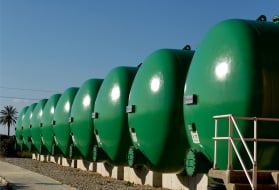sources of chlorine
Reading time:Chlorine gas or easily usable calcium and sodium hypochlorites are used to chlorinate water. When hypochlorite is added to water, this produces hypochlorous acid in the same way as chlorine hydrolysis. However, hypochlorite based reactions create hydroxide ions that will raise the water’s pH.


chlorine
Chlorine is commercially available as a liquid supplied in cylinders or tanks pressurised at 5 bar, each having a capacity of 50 kg or 1,000 kg of chlorine respectively (see chlorine).
sodium hypochlorite
Sodium hypochlorite NaOCℓ is formed by dissolving chlorine gas into a solution containing excess sodium :


The commercial water-based solution is known as "bleach", a greenish-yellow liquid that has a pH of between 11.5 and 13. The industrial strength solution has a concentration of 47 to 50° chlorometric corresponding to 149-159 g · L–1 of active chlorine. Household bleach has a concentration of approximately 15° chlorometric (47.5 g · L–1 of active chlorine). The sodium hypochlorite solution is relatively unstable. Its concentration can decrease during storage depending on its exposure to light, temperature and presence of impurities. Hypochlorite breakdown means that its concentration needs to be checked frequently to avoid fluctuation with the amount injected and to avoid the introduction of chlorite and chlorate ion by-products (see water treatment applications).
Solution of diluted sodium hypochlorite (< 3° chlorometric) can be produced on site from brine solution or sea water using membrane electrolysis (see water treatment applications).
hypochlorite de calcium
Calcium hypochlorite Ca(OCℓ)2 is used in solid form – pellets, granules or powder – and is mainly produced from the reaction between chlorine gas and lime slurry.


Commercial products contain 92 to 94 % by weight of calcium hypochlorite, or 65 to 70 % by weight of active chlorine. These products must be stored in a dry place, away from heat and organic matter in order to limit their breakdown and to prevent any violent reaction. Due to the impurities they contain (chlorate, metals…), it is recommended that the user does not exceed a certain concentration in water.
Bookmark tool
Click on the bookmark tool, highlight the last read paragraph to continue your reading later














